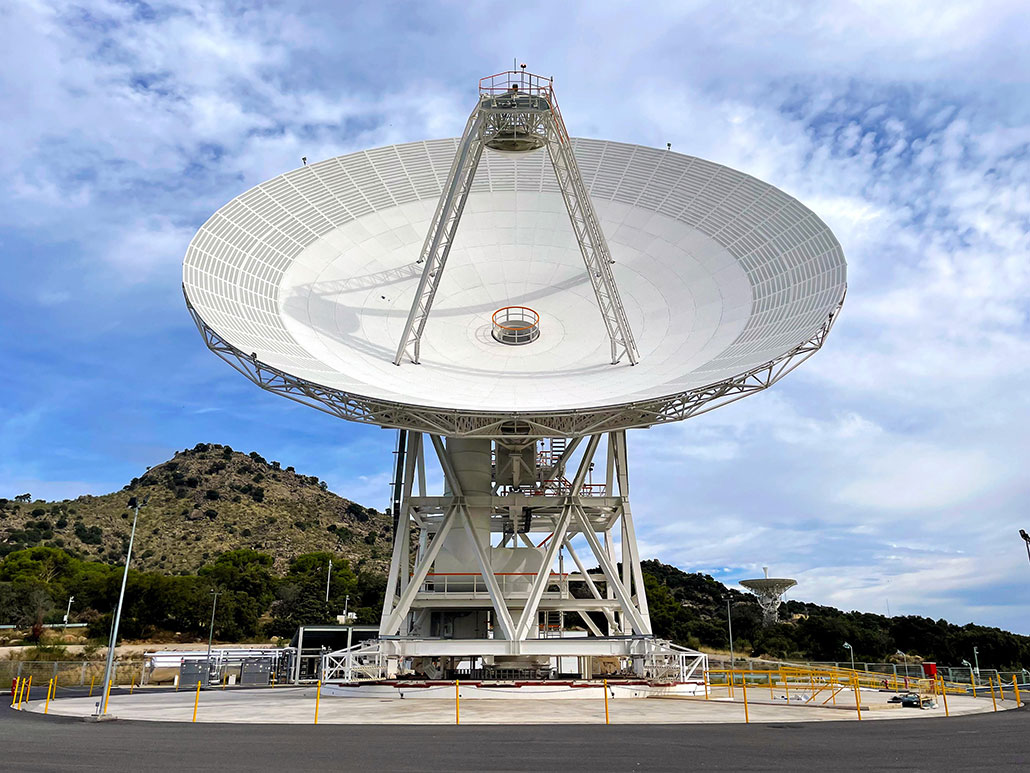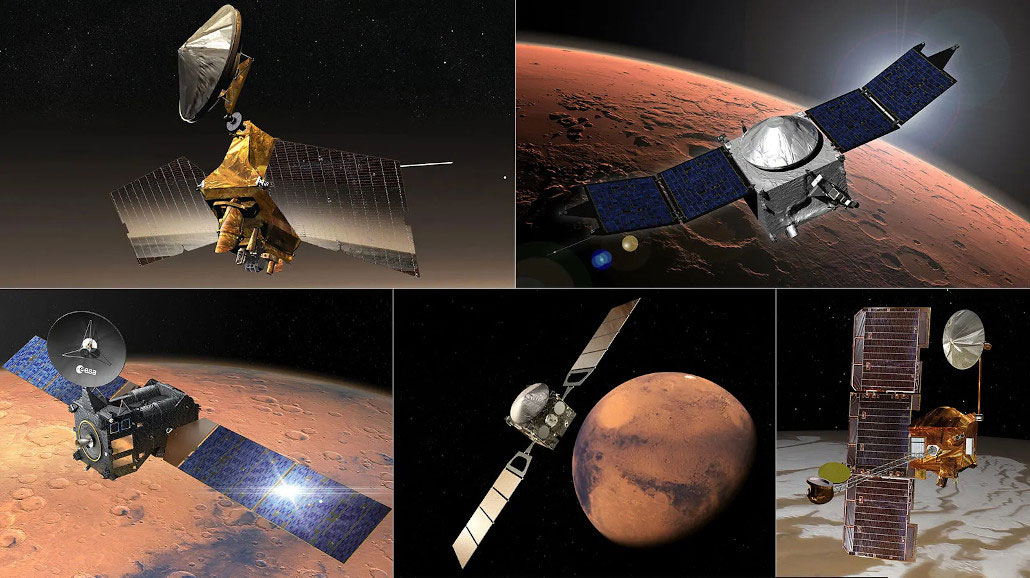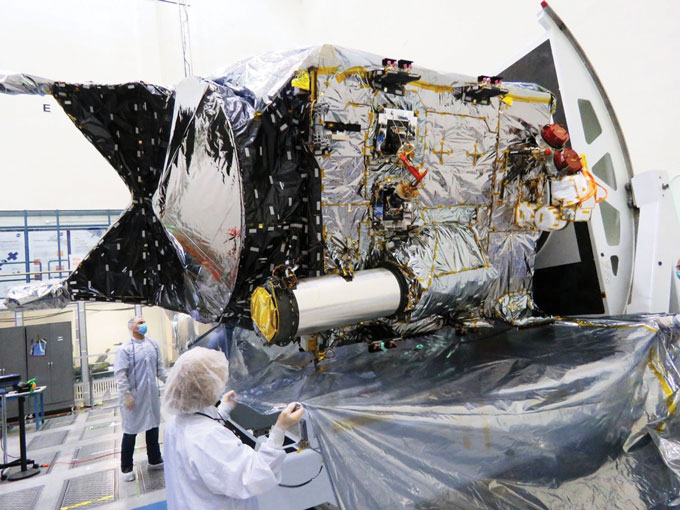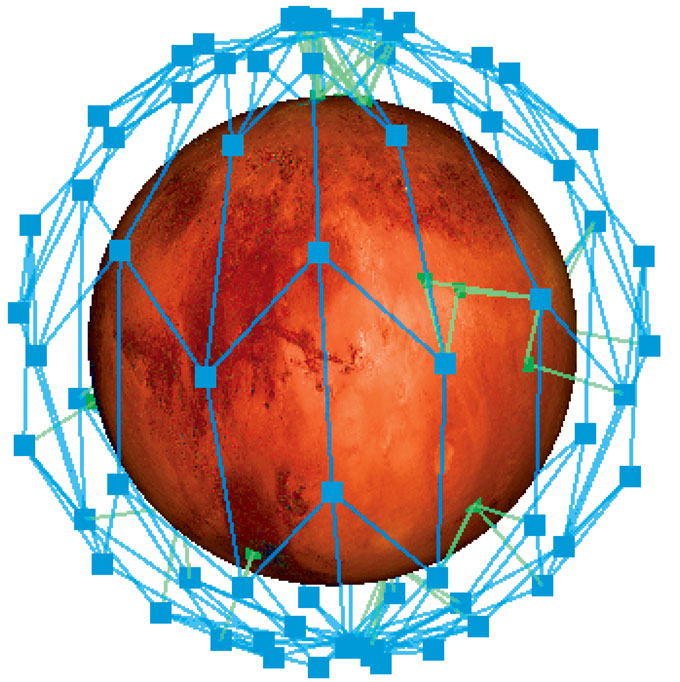During this summer, a team of students from MIT embarked on a journey to the sou …
Guide to creating an internet network on Mars
Emma Wordsmith

When the first astronauts touch down on Mars, possibly within a couple of decades, they will require a method of communication. They will need to converse among themselves and with mission control on Earth using equipment located on and around Mars.
Moreover, they will surely desire to send emails to their loved ones, keep their playlists current, or stream new episodes of their favorite shows. Connecting to Earth’s internet via Wi-Fi is not a feasible option. The distance between Earth and Mars is simply too vast.
The gap between the two planets varies depending on their positions in their orbits around the sun. It can span from approximately 55 million to 400 million kilometers (34 million to 250 million miles). Consequently, even data traveling at the speed of light would take anywhere from four to 24 minutes for a one-way journey.
This time delay makes a swift message exchange between Mars and mission control on Earth impossible. Making a WhatsApp call home is also out of the question.
Another challenge is “solar conjunction,” occurring every two years or so when Earth and Mars are on opposite sides of the sun. During this period, all signals between the two planets are blocked by the sun.
No known method can eliminate the signal delay between Earth and Mars or permit message transmission through the sun.
Researchers are exploring ways to make communication on Mars more similar to that on Earth, with one team even contemplating the possibility of Mars having its own internet.
Effective communication infrastructure is vital for human missions to Mars, according to Claire Parfitt, a systems engineer at the European Space Agency (ESA) in Noordwijk, Netherlands. She emphasizes the necessity for Martian residents to have a means of accessing the internet.
“At present,” she adds, “we are at the initial stages of determining what that entails.”
Current Mars Communication Methods
Various space agencies operate spacecraft on or near Mars, including landers and rovers on the planet’s surface (landers remain stationary, while rovers move). Additionally, satellites orbit the Red Planet, all requiring communication with Earth.
Exploring Space Robots
NASA’s Perseverance rover, affectionately known as Percy, engages in two types of data transmission: “command and telemetry” and scientific data exchange. Operators on Earth provide instructions to the rover, receive responses, and analyze the data, with Percy receiving over 1,000 commands daily from Earth.
Percy also shares scientific findings from its observations on Martian rocks and surroundings by transmitting data back to Earth.
The helicopter Ingenuity, which ended its mission earlier this year, communicated with Percy through data relay for operational purposes.
Orbiters circling Mars contribute to scientific data sharing with Earth. These include NASA’s Mars Odyssey and Mars Reconnaissance Orbiter (MRO), as well as ESA’s Trace Gas Orbiter.
Mars orbiters not only transmit their own data observations but also facilitate the relay of surface mission data back to Earth.
The Mars Relay Network, comprised of five orbiters surrounding Mars (NASA’s MAVEN, ESA’s Mars Express orbiter, and the three mentioned above), coordinates data transmission between Mars and Earth. All five orbiters possess antennas directed towards Earth for data transmission, requiring precise synchronization, according to NASA.

For transmitting the latest observations from a rover back to Earth, data is first sent via radio waves to one of the orbiters in the Mars Relay Network. If the orbiter has a clear line of sight to Earth, data can be instantly beamed back using radio waves; otherwise, it waits to relay the data until Earth is visible.
Potent radio antennas on Earth pick up the broadcasted data from the orbiter. A global network of radio receivers, like NASA’s Deep Space Network, constantly monitors for deep space signals.
While this system is efficient for robotic missions on Mars, it will need enhancements when human astronauts arrive.
Connecting to Earth
Most instructions for Perseverance and other Martian rovers are transmitted from Earth directly via “X-band” radio waves. Data from Percy to Earth is mostly sent through “ultrahigh-frequency” (UHF) radio waves, which are also used to relay data to orbiters in the Mars Relay Network. These spacecraft possess large antennas for data transmission to Earth. When the helicopter Ingenuity was operational on Mars, Percy communicated with it using UHF radio waves.

Mars Communication Revamps
Vincent Chan, an expert in fiber-optic and satellite communications at the Massachusetts Institute of Technology, anticipates that local, ground-based communication will not pose a significant hurdle for Mars explorers.
Unlocking the Secrets of Surviving Mars
A possible solution for crew interactions is existing wireless technology that employs radio waves for transmitting messages. Two miniature cell towers could suffice when astronauts are nearby. In cases where they are far apart, a device capable of capturing and forwarding radio waves could bridge the communication gap similar to how individuals in remote areas on Earth connect.
“These services are already operative,” Chan notes, emphasizing their cost-effectiveness.
An extensive antenna on the crew’s landing module that is directed towards Earth would likely be the primary setup for Martian explorers, routing all communications to and from Earth.
However, when the antenna lacks a direct line of sight to Earth, orbiters similar to the Mars Relay Network could serve as intermediaries. The crew’s ground-based antenna would transmit messages to an orbiter, which in turn relays the data between other orbiters until a clear line of sight to Earth is established. This setup would necessitate multiple orbiters for continuous coverage and the capacity to handle substantial data shares.

ESA is investigating methods to enhance the current Mars Relay Network. The agency is exploring a concept known as MARCONI, short for the Mars Communication and Navigation Infrastructure. Should this project advance, it would establish communication and navigation spacecraft capable of accompanying future Red Planet missions.
Upon reaching Mars orbit, these spacecraft would manage radio communication on and with Mars, as explained by Parfitt. They could remain operational for subsequent missions.
Increasing payload to Mars escalates costs, as Parfitt stresses. “So one wouldn’t necessarily desire to transport extensive communication systems to Mars on every visit.”
Hence, spacecraft in Mars’ vicinity primarily communicate via radio waves. While this suffices for non-human explorers, future astronauts may necessitate significantly higher data transfer rates for transporting vast amounts of data, possibly opting for laser communications.
Need Help with a Science Inquiry? We’ve Got You Covered!
Ask your question here, and your query could be addressed in an upcoming issue of Science News Explores
Laser Communication in Space
Laser light consists of optical waves with significantly higher frequencies than radio waves. The closely spaced crests and troughs of optical waves allow dense data packing compared to radio waves. In fact, lasers might carry 10 to 100 times more data in the same duration as radio waves.
However, laser-based deep space communication necessitates testing.
NASA’s Psyche mission plays a pivotal role in this area. Launched last October, the spacecraft’s primary objective is to examine an asteroid situated between Mars and Jupiter. Concurrently, the mission carries NASA’s Deep Space Optical Communications technology, facilitating long-distance laser communication tests through space.

Laser signals have never been tested from distances beyond the moon. However, in November, Psyche transmitted data to Earth from a distance of 16 million kilometers (10 million miles), 40 times farther than the moon. Subsequently, it broadcasted a video of a cat named Taters from 31 million kilometers (19 million miles) away.
ESA is also exploring long-range laser communication under programs like ScyLight (pronounced “skylight”), focusing on developing secure and rapid optical and quantum communication technologies for space applications.
Despite its advantages, laser communication presents challenges. It necessitates extreme precision in aiming, unlike radio waves that disperse in space. Additionally, cloud cover and atmospheric interference hinder laser signals. Implementing lasers would entail upgrading existing Deep Space Network radio antennas or constructing new receivers capable of detecting deep space laser signals.
An Internet on Mars
Future Martian inhabitants will likely aspire to more than basic messaging. Establishing a Mars internet akin to Earth’s network could allow photo sharing and information lookup.
In June 2023, two computer specialists outlined a proposal to realize this vision. They suggested a fleet of Mars-orbiting satellites could create a Red Planet version of the internet, providing a satellite-based system akin to Starlink, a network of satellites in low Earth orbit managed by SpaceX. While satellite-based Earth internet access is costly, a Martian satellite system might present a more economical and feasible solution compared to ground-based fiber-optic cable networks.
Calculations by Pfandzelter and Bermbach indicated that a constellation of 81 Mars-orbiting satellites could offer global Martian coverage. This local communication infrastructure would extend Earth’s internet to Mars.
Consider an astronaut on Mars attempting to watch a Netflix show. “If you were to stream it directly from Earth, you’d have to endure a 10, 15, or even 40-minute wait,” describes Pfandzelter. This setup would lead to a fragmented viewing experience. Similarly, other astronauts on Mars would face similar buffering delays.

The 81 Mars satellites could facilitate local data storage, enabling the upload of a movie from Earth to the satellite system once for subsequent instant access by Martian astronauts. This locational data storage ensures an Earth-like streaming experience, with background uploads and downloads to and from Earth continuing.
Deploying internet satellites around Mars obviates the need for extensive surface installations. This presents a cost-effective alternative, as Pfandzelter highlights, “It would be much cheaper to just send a bunch of networking satellites to Mars.” These satellites could utilize either radio or optical waves, if laser technology proves feasible.
Drawing Insights from Lunar Endeavors
Moon missions offer valuable lessons for establishing a Martian internet. NASA’s Artemis program seeks to return humans to the moon, collaborating with private companies to establish a 4G network using radio waves that includes robust antennas and base stations equipped to withstand lunar conditions.
Similarly, ESA’s Moonlight program invites private space enterprises to deploy satellites around the moon, enabling communication between the far side of the moon and Earth. The program’s initial phase entails launching the Lunar Pathfinder orbiter in 2026.
Exploring the Marvels of Mars
“All lunar endeavors hold Mars as the ultimate objective,” Tomas Navarro, a future projects engineer at ESA in London, asserts. Despite potential human missions to Mars being distant, planning early is crucial. Although live planet-to-planet video calls are infeasible, addressing other challenges could pave the way for successful Red Planet missions and enhance preparedness for astronomical exploration.


